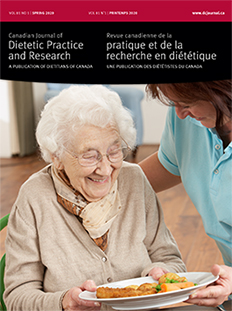Abstract
Purpose: The purpose of this study was to explore the impact of dietary factors and biomarkers on lung function among Canadian adults (18–79 years).
Methods: Our data source was the Canadian Health Measures Survey Cycle-3, which included 3397 adults. The household and clinic questionnaires and physical measures were used to assess individual dietary factors, modified Mediterranean Diet Scores, and biomarkers.
Results: The overall mean percent predicted values for FVC and FEV1 were 97% and 95%, respectively. While somewhat inconsistent between outcomes, higher lung function was associated with bean, grain, milk, fruit, and vegetable consumption, whereas lower lung function was associated with egg and potato consumption. Among the biomarkers, vitamin D, chloride, total serum protein, and red blood cell folate were associated with higher lung function, whereas C-reactive protein and vitamin B12 was associated with lower lung function.
Conclusion: Our study provides support for an association between some dietary factors and lung function, though not entirely consistent between a specific dietary factor and the outcomes studied (FVC, FEV1, FVC/FEV1, and FEF25%–75%). The associations between a specific biomarker and lung function were more consistent (i.e., observed with a larger number of lung function outcomes) than were the dietary factors.
Résumé
Objectif. L’objectif de cette étude était d’explorer l’impact des facteurs alimentaires et des biomarqueurs sur la fonction pulmonaire des adultes canadiens (18-79 ans).
Méthodes. Notre source de données était le cycle 3 de l’Enquête canadienne sur les mesures de la santé, qui comprenait 3 397 adultes. Le questionnaire auprès des ménages et le questionnaire de la partie clinique ainsi que des mesures physiques ont été utilisés pour évaluer les facteurs alimentaires individuels, l’indice du régime méditerranéen modifié et les biomarqueurs.
Résultats. Les valeurs prévues moyennes en pourcentage pour la capacité vitale forcée (« FVC ») et le volume expiratoire maximal par seconde (« FEV1 ») étaient de 97 % et de 95 %, respectivement. Bien que les résultats soient quelque peu incohérents, une meilleure fonction pulmonaire a été associée à la consommation de haricots, de céréales, de lait, de fruits et de légumes, alors qu’une fonction pulmonaire plus faible a été associée à la consommation d’œufs et de pommes de terre. Parmi les biomarqueurs, la vitamine D, le chlorure, les protéines sériques totales et le folate érythrocytaire ont été associés à une meilleure fonction pulmonaire, alors que la protéine C-réactive et la vitamine B12 ont été associées à une fonction pulmonaire plus faible.
Conclusions. Notre étude appuie une association entre certains facteurs alimentaires et la fonction pulmonaire, même si elle ne montre pas une cohérence parfaite entre un facteur alimentaire précis et tous les résultats étudiés (FVC, FEV1, FVC/FEV1 et FEF25%–75%). Les associations entre un biomarqueur précis et la fonction pulmonaire sont plus cohérentes (c.-à-d. observées dans un plus grand nombre de résultats liés à la fonction pulmonaire) que les facteurs alimentaires.



